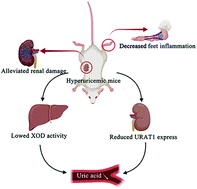Discovery of a novel rice-derived peptide with significant anti-gout potency†
Abstract
As a metabolic disease, gout, which seriously affects the normal life of patients, has become increasingly common in modern society. However, the existing medicines cannot completely meet the clinical needs. In the current study, a novel short peptide (named rice-derived-peptide-2 (RDP2), AAAAGAMPK-NH2, 785.97 Da) was isolated and identified from water extract of shelled Oryza sativa fruits, without toxic side effects but excellent stability. Our results indicated that RDP2 (the minimum effective concentration is 5 μg kg−1) induced a significant reduction in serum uric acid levels in hyperuricemic mice via suppressing xanthine oxidase activity and urate transporter 1 expression, as well as alleviated renal damage through inhibiting the activation of NLRP3 inflammasome. In addition, RDP2 can also alleviate paw swelling and inflammatory reactions in mice after subcutaneous injection of monosodium urate crystals. As mentioned above, we obtained a novel peptide which could work through all stages of gout, not only reducing uric acid levels and renal damage in hyperuricemic mice, but also alleviating inflammatory responses associated with acute gout attack, and thus provided a new peptide molecular template for the development of anti-gout drugs.



 Please wait while we load your content...
Please wait while we load your content...